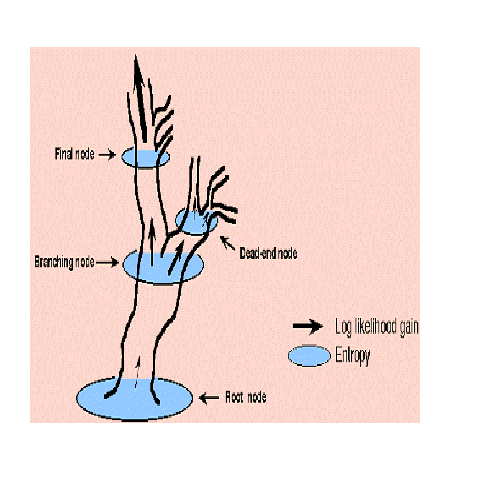The
Maximum Entropy Method: Traditional direct methods have
proved to be immensely successful when applied to single crystals where the
diffraction data are complete and have atomic resolution (i.e. around
1.1Å), but this leaves whole classes of important problems which are inaccessible
to such techniques i.e. electron diffraction data, powders, proteins
and surfaces.
A new method, the maximum
entropy (ME) formalism, has the potential to tackle these problems, and has
been developed as a practical technique for solving crystal structures. Based
on information theory and using Bayesian statistics, it builds electron density
through constrained entropy maximisation.
 |
Phasing
tree in the maximum entropy method |
References
for Maximum Entropy Methods:
- 'A Multisolution Phase
Determination Method in X-ray Crystallography', C.Bannister, G.Bricogne &
C.J.Gilmore, in Bayesian Methods and Maximum Entropy, Ed. J.Skilling,
Kluwer, (1989), 225-232.
- 'A Multisolution Method
of Phase Determination by Combined Maximisation of Entropy and Likelihood.
I: Theory, Algorithms and Strategy', G.Bricogne & C.J.Gilmore, Acta
Cryst, (1990), A46, 284-297.'A
Multisolution Method of Phase Determination by Combined Maximisation of Entropy
and Likelihood. II: Applications to Small Molecules', C.J.Gilmore, G.Bricogne
& C. Bannister, Acta Cryst. (1990), A46, 297-308.
- ‘Maximum Entropy, Likelihood
and the Phase Problem in Single Crystal and Powder Diffraction' C.J. Gilmore
& G.Bricogne in Crystallographic Computing 5, Ed. D.Moras Oxford
University Press, (1991), 298-307.
- 'A Multisolution Method
of Phase Determination by Combined Maximisation of Entropy and Likelihood.
VI Automatic Likelihood Analysis via the Student t-test, with an application
to the Powder Structure of Magnesium Boron Nitride', K.Shankland, C.J. Gilmore,
G.Bricogne, & H.Hashizume, Acta Cryst. (1993), A49, 493-501.
- 'Applications of the
Maximum Entropy Method to Powder Diffraction and Electron Crystallography',
C.J.Gilmore, K.Shankland & G.Bricogne Proc. Roy. Soc. Series A,
(1993), 442, 97-111.
- 'Maximum Entropy, Likelihood
Ranking and the Phase Problem for Single Crystal, Powder Diffraction and Electron
Microscopy' C.J.Gilmore in Crystallographic Computing 6: A Window on Modern
Crystallography, Ed. H. Flack, Oxford University Press, (1993), 25-46.
- 'The MICE Computer Program,
and its application to Direct Phase Determination for Powders, Electron Diffraction
and Macromolecules', C.J.Gilmore & W.Nicholson Trans. Amer. Cryst.
Association. (1994), 30, 15-27.
- 'Maximum Entropy and
Bayesian Statistics in Crystallography' C.J.Gilmore, Acta Cryst. (1996),
A52, 561-589
- 'MICE Computer Program'
C.J.Gilmore & G.Bricogne Methods in Enzymology (1997), 277,
65-78.
- 'An Introduction to
Maximum Entropy in Action' C.J.Gilmore in Electron Crystallography,
Ed. S.Fortier, Kluwer (1998), 109-117.
- 'Structure Determination
using Maximum Entropy and Likelihood' C.J.Gilmore in Electron Crystallography,
Ed. D.L.Dorset, Kluwer (1997), 295-304.
- 'Developments in Maximum
Entropy and Likelihood' C.J.Gilmore in Direct Methods in Macromolecular
Crystallography, Ed. S.Fortier, Kluwer, (1998), 455-462.
- 'A Multisolution Method
of Phase Determination by Combined Maximisation of Entropy and Likelihood.
VI The Use of Error-Correcting Codes as a Source of Phase Permutation and
their Application to the Phase Problem in Powder, Electron and Macromolecular
Crystallography’ C.J. Gilmore, W. Dong & G.Bricogne, Acta Cryst.
(1998), A55, 70-83.
- 'Direct Determination
of the Modulated Lamellar "Ripple" Phase of Hydrated Lecithin' D.L.Dorset
& C.J.Gilmore Z. Krist. (1998), 213, 432-435.

